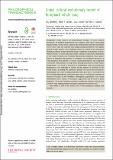Files in this item
Global cultural evolutionary model of humpback whale song
Item metadata
| dc.contributor.author | Zandberg, Lies | |
| dc.contributor.author | Lachlan, Robert F. | |
| dc.contributor.author | Lamoni, Luca Ubaldo | |
| dc.contributor.author | Garland, Ellen Clare | |
| dc.date.accessioned | 2021-09-07T09:30:16Z | |
| dc.date.available | 2021-09-07T09:30:16Z | |
| dc.date.issued | 2021-10-25 | |
| dc.identifier | 274672306 | |
| dc.identifier | ea60c062-8b28-4130-b7ba-20232085b586 | |
| dc.identifier | 000693558500002 | |
| dc.identifier | 85115818856 | |
| dc.identifier.citation | Zandberg , L , Lachlan , R F , Lamoni , L U & Garland , E C 2021 , ' Global cultural evolutionary model of humpback whale song ' , Philosophical Transactions of the Royal Society. B, Biological Sciences , vol. 376 , no. 1836 , 20200242 . https://doi.org/10.1098/rstb.2020.0242 | en |
| dc.identifier.issn | 0962-8436 | |
| dc.identifier.other | ORCID: /0000-0002-8240-1267/work/99804641 | |
| dc.identifier.uri | https://hdl.handle.net/10023/23913 | |
| dc.description | Funding: ECG is funded by a Royal Society University Research Fellowship (UF160081). RFL and LZ are funded by the BBSRC (BB/R008736/2). LL was supported by a Leverhulme Trust Grant to Luke Rendell (among other recipients; grant reference RPG-2013-367) | en |
| dc.description.abstract | Humpback whale song is an extraordinary example of vocal cultural behaviour. In northern popula-tions, the complex songs show long-lasting traditions that slowly evolve, while in the South Pacific, pe-riodic revolutions occur when songs are adopted from neighbouring populations and rapidly spread. In this species, vocal learning cannot be studied in the laboratory, learning is instead inferred from the songs’ complexity and patterns of transmission. Here, we used individual-based cultural evolutionary simulations of the entire Southern and Northern Hemisphere humpback whale populations to formalise this process of inference. We modelled processes of song mutation and patterns of contact among popu-lations and compared our model with patterns of song theme sharing measured in South Pacific popula-tions. Low levels of mutation in combination with rare population interactions were sufficient to closely fit the pattern of diversity in the South Pacific, including the distinctive pattern of West-to-East revolu-tions. Interestingly, the same learning parameters that gave rise to revolutions in the Southern Hemi-sphere simulations gave rise to evolutionary patterns of cultural evolution in the Northern Hemisphere populations. Our study demonstrates how cultural evolutionary approaches can be used to make infer-ences about the learning processes underlying cultural transmission and how they might generate emergent population-level processes. | |
| dc.format.extent | 12 | |
| dc.format.extent | 2872976 | |
| dc.language.iso | eng | |
| dc.relation.ispartof | Philosophical Transactions of the Royal Society. B, Biological Sciences | en |
| dc.subject | Vocal learning | en |
| dc.subject | Individual-based simulations | en |
| dc.subject | Cultural transmission | en |
| dc.subject | Song | en |
| dc.subject | Cultural evolution | en |
| dc.subject | GC Oceanography | en |
| dc.subject | QH301 Biology | en |
| dc.subject | DAS | en |
| dc.subject.lcc | GC | en |
| dc.subject.lcc | QH301 | en |
| dc.title | Global cultural evolutionary model of humpback whale song | en |
| dc.type | Journal article | en |
| dc.contributor.sponsor | The Royal Society | en |
| dc.contributor.sponsor | The Leverhulme Trust | en |
| dc.contributor.institution | University of St Andrews. School of Biology | en |
| dc.contributor.institution | University of St Andrews. Centre for Biological Diversity | en |
| dc.contributor.institution | University of St Andrews. Sea Mammal Research Unit | en |
| dc.contributor.institution | University of St Andrews. Centre for Social Learning & Cognitive Evolution | en |
| dc.identifier.doi | https://doi.org/10.1098/rstb.2020.0242 | |
| dc.description.status | Peer reviewed | en |
| dc.identifier.grantnumber | UF160081 | en |
| dc.identifier.grantnumber | en |
This item appears in the following Collection(s)
Items in the St Andrews Research Repository are protected by copyright, with all rights reserved, unless otherwise indicated.

